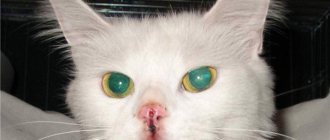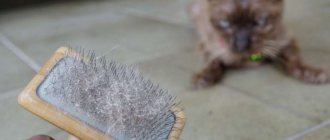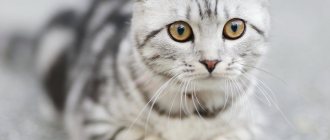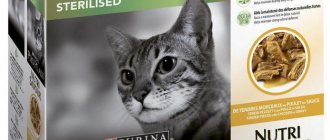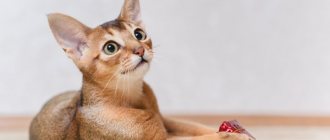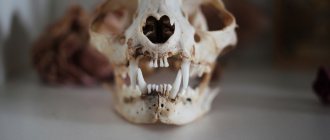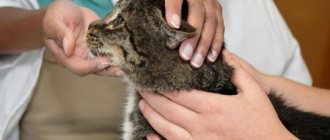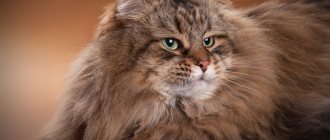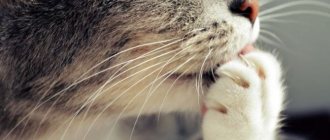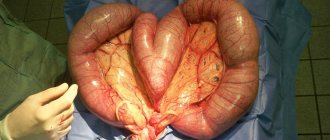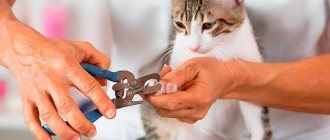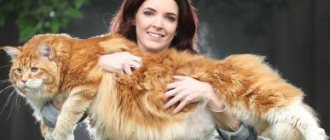Owners of mustachioed pets often encounter damage to furniture. The thing is that at home, a cat’s claws practically do not wear down naturally. Because of this, any available materials are used.
The most drastic way to eliminate the problem is declawing surgery, but such an intervention has many disadvantages. Such an impulsive decision will definitely affect your pet's quality of life, so you should choose safer alternatives instead.
Number of claws
First, let's figure out how many claws a cat has. Despite the number of limbs, there are not 20, but only 18.
How many claws does a cat have on its front paws?
Understanding how many claws a cat has on its front paws is very simple. You need to pick up your pet and carefully examine it. As we explore, it will become clear that at least here we are similar.
At the base of the cat's front foot there are 4 toes, and a little further away there is another additional one, similar to ours, the big one. The claw on this finger makes it easier to grasp objects.
How many claws does a cat have on its hind legs?
You might be surprised to find out how many claws cats have on their hind legs. There are only 4 fingers here. Thus, the total number really is exactly 18.
Recommendations for choosing a nail clipper for a cat
- Examine your pet's paws. Pay attention to the thickness of your nails. If the nails are thin and even translucent, which happens in small cats, then it is advisable to use pliers or scissors. If the claws are dense, it is better to opt for a guillotine or a grinder.
- When choosing a tool, make sure that the blades are made of high-strength steel and are sharp enough. Poorly sharpened blades can cause discomfort to the animal, or even injure it. After treating the claws with such a device, it is likely that the nails will begin to peel.
- Pay attention to the details: rubberized inserts at the handles will provide a more reliable connection between the hand and the tool. This is necessary so that at a crucial moment the tool does not slip out of your hands.
- Hold the nail clipper in your hands and listen to your feelings. It is important that you are comfortable. You cannot allow yourself to lose control of the process due to discomfort. Possible harm to the animal.
Structure of a cat's claw
Cat claws are a specific type of skin, close to the human nail plate. They consist of the epidermis, the outer layer of skin containing large amounts of keratin.
This substance serves to protect soft sensitive tissues hidden in the inner part of the claws - the pulp. It is easy to spot by its pinkish tint. The pulp contains nerve fibers and choroid plexuses, so damage to this area is accompanied by acute pain and bleeding.
It's also worth noting the shape. Most whiskered pets are equipped with sickle-shaped claws, but there are exceptions. For example, the Persians have curved ones. During fights, these cats inflict more dangerous injuries on their opponents, since this shape makes it easier to get right under the skin.
Navigating in space
Finally, it is worth mentioning what a cat’s sense organs are made of. This includes not only the eyes, ears and nose, but also the tongue and whiskers.
The vision of a genius
Whiskered pets see perfectly in the dark, distinguish 3 colors (red, blue, green) and as many as 25 shades of gray. The mysterious glow of their huge eyes at night is explained by the tapetum - a special vascular layer located behind the retina.
Thanks to the convex cornea, the viewing angle of these animals is almost 270°, so with the help of their necks they are able to assess the situation at all 360°.
Whiskers
The tactile function is performed by vibrissae, that is, cat whiskers. In fact, they also belong to hairs, but their follicles lie much deeper than the guard coat and undercoat. They actively interact with nerve impulses, determining the surrounding temperature, perceiving signals of pain and pleasant touches.
These tactile hairs are found not only on the face, but also on the hind legs. Because of this, mustachioed pets actively shake them when they step in the mud or enter the water.
Pulling or cutting mustaches is strictly prohibited. In addition to acute pain, the animal may permanently lose its tactile function, which will affect orientation in space and mental health.
Nose-sniffer
The cat's nose contains 80 million olfactory receptors, so its sensitivity is 2 times higher than that of humans. Additionally, the Jacobson's organ, a small tube located on the upper palate, is responsible for the perception of odors.
Another interesting fact is that the imprint of a wet cat’s nose, like the pads of human fingers, is unique. Thanks to this, it can easily be classified as biometric data.
Ears-on-top
The developed hearing of furry pets even detects ultrasound. Its ears, consisting of an outer, middle and inner part, are responsible for this. The task of the first is to collect sound, the second is to transmit a sound signal, and the third is to convert sound vibrations into nerve impulses.
Thanks to this feature, animals moving to the dacha in the summer can easily find their way back during their walks. Having moved away 3 km, they perfectly hear the voices of their owners and other sounds associated with a country house.
Tongue - lover of food
Despite night vision, an excellent sense of smell and acute hearing, cats are inferior to us in some ways. The tongue has only 473 taste buds, while the human tongue has as many as 9,000.
Whiskered pets are good at distinguishing sour, salty and bitter foods, but almost unable to detect sweet ones. The love for ice cream is explained by its similarity to milk, familiar from childhood. For this reason, treats should be avoided as animals become lactose intolerant as adults.
Separately, it is worth noting 2 special receptors that are not typical for humans. One recognizes the taste of umami, that is, monosodium glutamate, and the second recognizes the taste of water. This is why cats often steal sausages and have a special love for unstagnant tap water.
Functions of a cat's claws
A cat's claws perform a number of important functions. The most important ones include the following:
- Protective. Whiskered pets use their “edged weapons” for defense against enemies and during hunting, easily tearing apart the soft tissues of caught prey.
- Depreciation. Allows you to land correctly when jumping, maintaining the integrity of your legs and spine even when falling from high floors.
- Communicative. Leaving peculiar marks is a way of marking one’s territory and warning potential rivals.
- Maintaining balance. With the help of additional support, animals can easily move along trees, window sills and various shaky surfaces.
- Muscle relaxation. Clinging to the carpet with its claws, the cat stretches its stiff and overstrained limbs.
- Facilitating the hunting process. The claws retract and extend thanks to tendon ligaments and muscle fibers. A sneaking pet removes them and silently moves towards the victim almost on its toes, without completely stepping on the foot.
The desire to scratch and grind everything around is a completely natural physiological state for all representatives of the cat family. It occurs due to periodic detachment of the stratum corneum as it grows.
How many pairs of legs does a mosquito have?
Six legs and four wings.
Interesting materials:
What countries are in the historical-geographical region of Latin America? Which countries were not affected by the Thirty Years' War? Which countries do not recognize Palestine? Which countries don't speak English? Which countries in Oceania were colonies of Great Britain? Which countries have opened their borders to tourists from Russia? Which countries are open to tourists? Which countries celebrate Victory Day on May 8? Which countries belong to the European Union? Which countries belong to the Nordic countries?
Why you shouldn't declaw a cat
Onychectomy, or declawing cats, amounts to animal cruelty in several European countries. The thing is that this operation involves partial removal of the phalanx, which is accompanied by difficult long-term rehabilitation and carries very high risks for the person being operated on. The main consequences include the following:
- Formation of abscesses in internal organs. The rupture of these formations is fraught with blood poisoning.
- Acute pain syndrome. After onychectomy, the animal loses its usual activity and appetite, since the wounds take a very long and painful time to heal.
- Fall of immunity. Due to constant stress, the immune response is reduced, leading to more frequent and more severe illnesses.
- Impaired musculoskeletal function. Along with the claws, the former grace is lost, which negatively affects the spine. Also, due to loss of coordination, the number of injuries increases.
- Losing a tool for self-defense. Meeting other animals on a street walk can result in very serious consequences, since the cat has nothing else to protect itself with. If he gets lost, the chances of finding him alive are close to zero.
- There is a high probability of developing osteomyelitis - purulent-necrotic inflammation that destroys bones.
- Heavy bleeding. The animal may die due to excessive blood loss not only during surgery, but during the rehabilitation period.
- Mental change. Loss of a sense of security increases aggression, so the operated pet often attacks its owners. He becomes alienated and withdrawn due to constant fear.
- Regularly relieving yourself in the wrong place. Raking excrement with injured paws causes severe pain, so any cat litter causes severe rejection. For this reason, the cat chooses secluded corners with a soft surface.
- Various diseases of internal organs. Low activity is the main reason for weight gain, so pathologies of the cardiovascular system and gastrointestinal tract develop along with obesity.
Despite the huge number of disadvantages, there are exceptions when onychectomy is truly necessary. This radical method of treatment is resorted to when affected by a cancerous tumor progressing in the claw area.
Where do cats get their nails cut?
Of course, the most budget-friendly option is to trim your pet’s claws yourself, at home. If you have no experience at all, read our article to the end. A specialized store will help you choose a nail clipper. Or choose scissors for trimming cat claws from the catalog in the Aliexpress online store using this link .
If you have never purchased on Aliexpress, then read the instructions in the article “ First order on Aliexpress .”
Some nuances can be suggested by friends who have animals and have the necessary experience.
If you still lack self-confidence, you can turn to professionals. Specialists in the field of animal care and hygiene are called groomers, and their specialty is grooming. There are salons of the same name where you can bring your pet. The pricing policy here depends on the services provided, the reputation of the store and other factors. You should trust the master not only because he will be able to carry out all the necessary manipulations efficiently. There are cases when, during the process of trimming, cats try to escape, for example, if they have not been accustomed to such a procedure since childhood. In this case, the help of a professional will save you from both physical and moral trials. It will protect your pet from unnecessary stress.
Sometimes four hands are better than two
Most often, owners who participate in various exhibitions, competitions, and photo shoots resort to the services of a specialist. Sometimes, the level of such events requires certain standards of appearance. Participants in such competitions become regular clients of grooming salons.
Sometimes a master’s creativity knows no bounds
How to deal with a cat scratching furniture and wallpaper
Declawing a cat is not an option. The consequences of such an operation do not at all justify the damage to your favorite furniture and repairs. If you care about your pet, choose one or several of the alternatives suggested below.
scratching post
Love for a scratching post does not appear immediately. Many pets are more delighted only by the packaging box, but thanks to the due persistence of the owners, over time they get used to its contents.
In addition to regular training and timely encouragement to sharpen claws in the right place, it is necessary to take into account the wishes of the animal itself. Not everyone likes standard vertical surfaces in the form of a column and a play complex, so don’t rush to give up until you’ve tried all the possible options.
Manicure
The easiest option is to trim the cat's claws. If you follow the basic recommendations, this procedure is not dangerous and painless.
Anti-scratch
Anti-scratch caps are soft vinyl or silicone caps that are placed on the claws and replaced as they grow. Despite the convenience, this product has several disadvantages.
Under the caps, a secretion produced by the glands on the fingertips accumulates, which is fraught with inflammation. Also, some overly active cats tear off the “anti-scratch” with their teeth and swallow them.
What you need to know about nail trimming?
Before you start trimming your pet's nails, weigh the pros and cons. It is advisable to accustom young kittens to trim their claws, who will eventually become completely accustomed to this procedure . If you decide to cut the claws of an adult cat, then he is unlikely to understand this, and besides, he may be very offended by you and not allow himself to be stroked.
It is worth noting that nail trimming is mandatory for show animals and cats participating in castrati shows.
How to care for a cat's claws
Cats are taught to trim their claws from an early age. Up to six months, babies simply have their paws examined periodically. Their fingers are still very fragile, so they can be accidentally injured.
It is recommended that the very first haircut be carried out in a veterinary clinic or grooming salon. In them you can ask in detail about the procedure and observe it from the outside.
How many times a month should you trim a cat's claws?
The frequency of haircuts varies from person to person. It depends on the speed of regrowth. Some pets need a manicure every 1.5-2 weeks, while others need a manicure only once a month.
Particular attention should be paid to those with black claws, Persian cats and sphinxes. In the former, it is difficult to find the pulp, so in their case, cutting is carried out frequently, but to the minimum possible length. “Persians” and Sphynxes are notable for increased detachment of the stratum corneum and also require more frequent procedures.
Tools
For a cat manicure, you will need a nail clipper from a veterinary pharmacy or nail clippers. It is better not to use ordinary scissors. They are more difficult to work with, so if you lack experience, you can damage your cat’s claws.
In addition to the main tool, you will need several additional ones:
- nail file to prevent splitting;
- antiseptic and cotton pads in case of emergency.
Before starting the procedure, be sure to disinfect all of the listed instruments. Otherwise, an accidental cut may cause an infection to get into the wound.
Haircut procedure
Take your pet in your arms and gently press on its paw. After releasing the claws, quickly and as confidently as possible cut off their transparent part. For reliability, it is recommended to move 2 mm away from the pulp and make a transverse section.
Note that the claws on the hind legs are shorter. The dead edge is smaller here, so the length of the cut should be shorter than on the front ones.
Claws as a natural means of attack, defense and a tool for practical use
The ancestors of cats were nocturnal, living in savannas and semi-deserts, spending part of their time in trees. Small, but very tenacious and strong claws in the shape of Turkish scimitars helped them deftly and quickly climb branches, escaping from larger predators, serving as a means of defense and helping to retain nimble prey.
Today, domestic cats remain essentially the same small, dangerous predators with sharp claws. They need their “weapons” for normal movement, since the claws serve as a kind of stoppers that prevent sliding, and also help to climb various surfaces.
Cats have 5 toes on their front paws, and 4 on their hind paws, plus one vestigial one. There are 18 claws in total and they are constantly growing. To get rid of the old part of the horny tissue and keep the “equipment” constantly sharp, cats need to sharpen their claws. It is for this purpose that the “scratching post” is used. It should be large enough so that the animal, stretching out to its full height, can sharpen its claws heartily.
If you do not provide the cat with the necessary accessories, events can go according to two scenarios:
- A well-mannered, good-natured creature will not harm the owner’s property, but will suffer itself. Very long claws, without constant grinding, grow strongly, bend and can dig into the pad or into the skin fold between the fingers. This can cause serious inflammation and suppuration. In severe cases, the infection penetrates the bone, “melting” it, and the cat may lose a toe. Such a defect will negatively affect its gait, agility and ability to hunt. In the wild, the injured animal would not have survived.
- When necessary, cats deftly give themselves a “manicure” by biting off the offending part of the claw. But it still needs to be sharpened, because sharp debris can injure the cat itself or the family. In the absence of a “claw”, its role will be played by completely inappropriate objects and not intended for this purpose. Owners should not be surprised or indignant if a cat tears a chair, the upholstery of an expensive leather sofa, or scratches the legs of valuable wooden furniture.
We invite you to familiarize yourself with the British Fold cat: character, care, health, features. There are several types of devices that can be used to trim a cat’s claws:
- Guillotine claw clipper. The instrument has a ring at the end into which the keratinized part is placed. After pressing the handle, a blade appears and cuts off the fragment. The guillotine is more suitable for experienced breeders. Without the skill, it is easy to cut off an area larger than required.
- Nail clipper-secateurs. Looks like pliers. There is a spring between the handles, which greatly facilitates the process.
- Nail clipper-scissors. They resemble a human device, but with indentations on the cutting surface. The claw is placed in the notch and cut off. This design eliminates slipping and the risk of crumbling the plate. For trimming at home, this is the best option.
Problems with claws in cats and kittens
Caring for a cat's claws includes not only regular trimming, but also periodic inspection. In some cases, the animal may require the help of a veterinarian.
Foliation
Peeling off of the stratum corneum is a common physiological process that encourages cats to grind off the excess. They talk about the problem only when the claws peel too much and significantly change their appearance.
The most common causes of this disorder are improper haircut and poor nutrition. In the first case, the problem is solved by using a file, and in the second, by taking tests and adding vitamins to the diet.
Ingrown
In addition to layering, improper trimming can lead to ingrown hairs. It is also triggered by injuries.
Treatment depends on the degree of ingrowth. In case of deep damage, suppuration and the appearance of blood, it is better to immediately consult a doctor. He will perform an operation to remove the ingrown part and prescribe antibiotics and painkillers for the rehabilitation period.
Polydactyly and ectrodactyly
Another possible problem is having too many or not enough fingers. Such anatomical deviations are divided into 2 types:
- Polydactyly. If the fingers are larger than normal, then they rarely interfere with the animal, but also do not give it any advantages.
- Ectrodactyly. If the required number of fingers is missing, the situation is reversed. Such paws look like claws and interfere with full movement. There is also a risk of developing pathologies of internal organs due to the greater load on the musculoskeletal system.
Polydactyly is inherited and is completely natural in Maine Coons. The absence of an extra finger in representatives of this breed is equivalent to marriage.
In the absence of serious inconvenience, the removal of extra fingers is not encouraged. In other cases, surgery is performed at an early age, since kittens are less sensitive to pain and recover faster after amputation.
About cat claws - a little more detail
How does it all work? Everyone is accustomed (and even specialized literature is guilty of this for clarity) to consider cat’s claws “retractable.” And in fact, if you look closely, you can see how they “move out” and “retract” back. Strictly speaking, this is not entirely true: rather, the claws are located in a special protective sheath, which the cat, in turn, knows how to control. Note that the cat releases its claws as needed; without it, in order to protect them, they are retracted inside and do not come into contact with surfaces.
You should not equate the concepts of “cat’s claws” and “fingernails.” Cat claws are really a whole mechanism that is an integral part of the foot, connected to the skeletal system and tissues of the animal. While a nail is nothing more than dead, hard tissue growing from the border of the nail bed. Cats control their claws using special muscles, ligaments and tendons.
